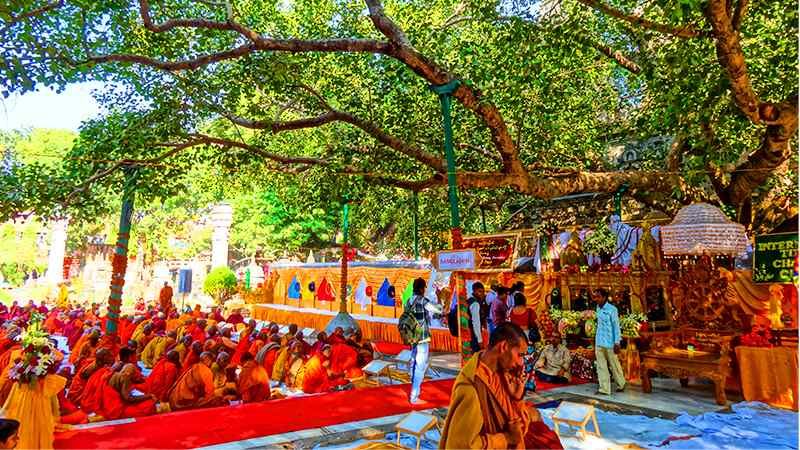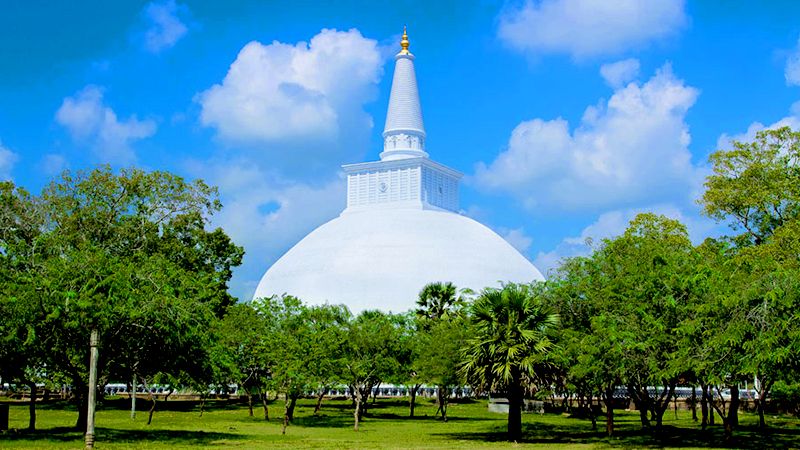
Bodhi Tree Anuradhpaura
Sri Maha Bodhi Tree (Scientific Name - Ficus Religiosa) is the oldest living tree in the recorded history. It is a sapling from the historical Bodhi tree, under which Buddha attained his enlightenment. It was planted in 288 BCE and is the world's oldest living human-planted tree with a known planting date. It was brought from Buddhagaya, India, by Ven. Sanghamitta Therini, a sister of Arhant Mahinda, who introduced the Buddha's Teachings to Sri Lanka. Recommended place for family holiday and Buddhist pilgrimage tours in Sri Lanka.

Ruwanwelisaya
Ruwanweli Maha Seya (Stupa) was built by the great king Dutugamunu, who reigned Anuradhapura from 137 BC to 119 BC. Ruwanweli Stupa is not the largest or the oldest of Anuradhapura's stupas, but it is the most revered by Buddhists, surpassing all other great stupas. It houses the most impressive collection of Gautama Buddha relics found in any dagaba on the island. This destination is famous for educational family holidays and for Buddhist pilgrimage travels in Sri Lanka.

Brazen Palace (Lowamaha apaya)
Lovamahapaya, also known as the Brazen Palace or Lohaprasada in Sri Lanka, is a collection of ruins with hundreds of stone pillars located between the stupa Ruvanvelisaya and the Great Sri Maha Bodhi Tree of Anuradhapura. This is the site of nine-story monastic structure built in the 2nd century BC by King Dutugmunu. The structure is said to have had a refectory, assembly hall, and chapter house, as well as a roof covered in bronze tiles (hence the name "Brazen palace"). The edifice's 400-foot-long sides were supported by 40 rows of 40 stone pillars, totaling 1600 pillars, the majority of which are still standing today. This is also listed as a Buddhist pilgrimage site in Sri Lanka.

Abhayagiri Monastery
Abhayagiri Vihara was a major Mahayana, Theravada, and Vajrayana Buddhist monastery in Anuradhapura, Sri Lanka. It is one of the world's most extensive ruins. Historically, it was both a great monastic center and a royal capital, with magnificent monasteries rising to many stories and roofed with gilt bronze or burnt clay tiles glazed in brilliant colors. "Abhayagiri," one of seventeen such religious units in Anuradhapura and the largest of its five major viharas, stood to the north of the city, surrounded by great walls and containing elaborate bathing ponds, carved balustrades, and moonstones.

Samadhi Buddha statue
The Samadhi Buddha Statue located in Maha Mewna garden in Anuradhapura is regarded as one of the finest sculptures of the Anuradhapura period which Buddha is depicted in the position of the Dhyana Mudra. It is thought to have been done in the third or fourth centuries. It is 7 feet 3 inches (2.21 M) tall and made of dolomite marble. This Samadhi Statue posture is universally known throughout the Buddhist world, and therefore one of the most typical pieces of Buddhist sculpture. Make sure to see this important place during your holiday in Sri Lanka.

Kuttam Pokuna (Twin Ponds)
Kuttam Pokuna, or the twin ponds, are another example of ancient Sri Lankan hydraulic engineering. These two ponds are part of the Abayagiri complex and were most likely used for bathing by the monks. The origins of these ponds are unknown, but they are thought to have been built during King Aggabodhi I's reign (575-608).
The smaller (northern) pond was built first, followed by the larger (southern) pond. They are linked at the bottom by a Terracotta pipeline. Good site for educational field tours especially on hydrology / ancient irrigation systems.

Mirisawatiya Dagoba
Mirisavetiya Stupa in Anuradhapura is one of the oldest Dagabas, dating back over 2100 years. This magnificent structure, built by the great king Dutugemunu, is a must-see for any visitor to the sacred city of Anuradhapura. King Dutugemunu built it as a Dagoba of the "Mahavihara" fraternity, but as monks began to live there, Mirisawetiya evolved into a separate monastery. Add this to the list of places to visit for your family adventure in Sri Lanka.

Isurumuniya
Isurumuniya is a Buddhist temple in Anuradhapura, Sri Lanka, near the Tissa Wewa (Tisa tank). In this Vihara, there are four noteworthy carvings. Isurumuniya Temple is famous Isurumuniya Lovers sculpturealso important Elephant Pond, and The Royal Family.
The temple was built by King Devanampiya Tissa, who ruled in the ancient Sri Lankan capital of Anuradhapura from 307 BC to 267 BC. This is another popular site for Buddhist pilgrimage in sri lanka.

Thuparama Stupa Dagoba
Thuparamaya Stupa is the oldest Stupa in Sri Lanka built after Buddhism was introduced to the island. The Thuparamaya, built by King Devanapiyatissa, houses the Buddha's sacred collar bone. This relic, a gift from India, attests to the cordial relations enjoyed by the then-ruler of Sri Lanka. The columns surrounding the stupa were part of the walkway that supported the sacred edifice's roof. The interior of such a structure must have been a stunning expression of wood engineering and skillful craftsmanship. Scholars and scientists continue to discuss and debate the edifice's conical design, which is unique in world architectural history. Recommended place during your architecture educational tour in Sri Lanka.

Jethavana Stupa
The Jetavanarama stupa, also known as Jetavanaramaya, is a Buddhist reliquary monument located in the ruins of Jetavana monastery in Anuradhapura, Sri Lanka, a UNESCO World Heritage Site. When King Mahasena of Anuradhapura built it, it was the world's tallest stupa at 122 meters (400 feet) and the third tallest structure in the world [4]. (273–301). He started building the stupa 49 years after the Mahaviharaya of Anuradhapura was destroyed. His son Maghavanna I finished the stupa, which was later renovated by Parakramabahu I of Polonnaruwa. The relic believed to be enshrined here is a portion of a sash or belt tied by the Buddha. This is another popular site for educational holidays for students.

Mihinthalaya
Mihintale is a mountain peak in Sri Lanka's Anuradhapura district. It is said to have been the meeting point between Mahinda, the Buddhist monk who arrived from India, and King Devanampiyatissa, where the formed preached the doctrine of Buddhism, which marked the beginning of Buddhism in Sri Lanka. Mihintale is now a revered site in Buddhist philosophy, with pilgrims flocking to the site each June. This is because Mahinda is thought to have arrived from India on Poson Full Moon Poya day, which is in June. Many religious monuments and artifacts can also be found in Mihintale. Visit this place during your Study tours to Sri Lanka.

Moonstone
The moonstone (Sandakada Pahana) is a permanent feature of Buddhist structures throughout history. This is a semicircular piece of stone that can be found at the bottom of most Buddhist buildings. Although most moonstones are semicircular in shape, square moonstones do exist. It is believed that moon stones began as blank square stones and evolved into semicircular shapes. Later stages saw the addition of a plethora of carved decorations. The moonstone's design has evolved significantly over time, with the highest level of creativity seen near the end of the Anuradhapura Era. An ideal addition to your list for educational holidays in south Asia.